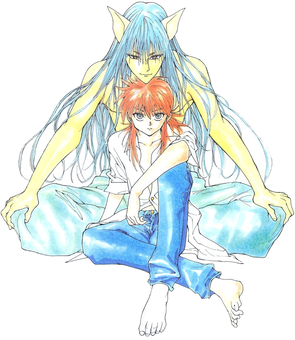
In Japanese folklore and Folklore, Sōjōbō is the mythical king and god of the tengu, legendary creatures thought to inhabit the mountains and forests of Japan. Sōjōbō is a specific type of tengu called daitengu and has the appearance of a yamabushi, a Japanese mountain hermit. Daitengu have a primarily human form with some bird-like features such as wings and claws. The other distinctive physical characteristics of Sōjōbō include his long, white hair and unnaturally long nose.

Kurama is a fictional character from the manga YuYu Hakusho by Yoshihiro Togashi. A Fox Demon reborn as the human Shuichi Minamino in modern life,[ch. 21] he is introduced as a thief who stole a supernatural mirror to save his dying mother from death. Although Kurama is initially portrayed as a villain, he becomes a supporting character to aid the protagonist Yusuke Urameshi in the next arc. Across his fights are revealed events from his past life as a demon, into which he becomes able to transform for a limited time. The character has also appeared in the anime adaptation, the two movies, and other related works.
The Kurama or T'kurmi or Akurmi language is a Kainji language of Nigeria. Kurama speakers are found in the central northern Nigerian states of Kaduna, Bauchi, Borno, Kano, Jigawa and Plateau.

The Shirane-class destroyers were a pair of Japanese destroyers originally built during the late 1970s. They are built around a large central hangar which houses up to three helicopters and they are the natural successor of the Haruna-class destroyers.

Kurama (鞍馬) was the final vessel of the two-ship Ibuki class of armored cruisers in the Imperial Japanese Navy. Kurama was named after Mount Kurama located north of Kyoto, Japan. On 28 August 1912, the Ibukis were re-classified as battlecruisers.

Mount Kurama is a mountain to the north of the Japanese city of Kyoto. It is the birthplace of the Reiki practice, and is said to be the home of Sōjōbō, King of the Tengu.

The Kurama-dera Cable is a funicular line operated by Kurama-dera, a famous Buddhist temple in Mount Kurama, Sakyō, Kyoto, Japan. The line is officially called Mount Kurama Cable Railway.

Eizan Electric Railway Co., Ltd. is a Japanese private railway company whose two lines run entirely in Sakyō-ku in the city of Kyoto, Kyoto Prefecture.

The Thyatirinae, or false owlet moths, are a subfamily of the moth family Drepanidae with about 200 species described. Until recently, most classifications treated this group as a separate family called Thyatiridae.

Kurama Station is the terminal station located on the Eizan Electric Railway (Eiden) Kurama Line in Sakyō-ku, Kyoto, Kyoto Prefecture, Japan.
Kurama Tengu: Kyōfu Jidai is a 1928 black and white Japanese silent film with benshi accompaniment directed by Teppei Yamaguchi. It is part of the Kurama Tengu series and features the battle between the title character, Kurama Tengu, and his impostor. The last scene, featuring sword fights of exhilarating speed, is one reason this series was very popular, especially with children.
Kurama Tengu is a fictional character in Japanese literature, cinema and TV. The popular series comprises numerous films and television dramas based on the original novel written by Jirō Osaragi.

Kanjūrō Arashi was a Japanese film actor. His nickname was "Arakan." He is famous for playing the role of Kurama Tengu sereies. He entered the film industry in 1927 and came to fame playing Kurama Tengu, a character in the Bakumatsu era created by Jirō Osaragi in his novels. In the 1950s he portrayed the Emperor Meiji in several hit films and appeared in yakuza films in the 1960s. He won Mainichi Film Award for Best Supporting Actor award for his role in The Profound Desire of the Gods.

Kyousougiga is a Japanese original net animation (ONA) series created by Izumi Todo and produced by Toei Animation in collaboration with Banpresto. The animation was released on Nico Nico Douga and YouTube in December 2011. Five additional episodes were streamed between August and December 2012. An anime television series aired between October and December 2013.

Kurama-dera (鞍馬寺) is a temple in the far north of Kyoto, Japan which houses some National Treasures of Japan. It was a member of the Tendai sect and subordinate to Shōren-in from the 12th century until 1949 when it founded its own religious body. The object of worship is esoteric and unique to the temple. It is said to have been founded by a disciple of Jianzhen.

JS Kurama (DDH-144) was the second ship of the Shirane-class destroyer in service with the Japan Maritime Self-Defense Force (JMSDF).
Kurama is a rural locality in Tungatarovsky Selsoviet, Uchalinsky District, Bashkortostan, Russia. The population was 505 as of 2010. There are 8 streets.












